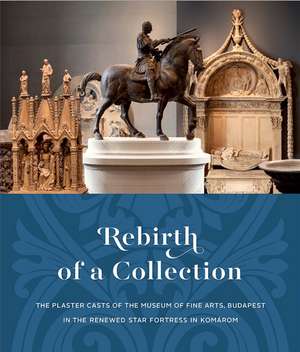Rebirth of a Collection: The Plaster Casts of the Museum of Fine Arts, Budapest in the Renewed Star Fortress in Komárom
Autor Miriam Szocsen Limba Engleză Paperback – 30 aug 2024
The nineteenth century was the period of establishing museums all over Europe. Led by noble ideas, our ancestors also founded important national collections in Hungary to make the foremost part of our cultural and historical heritage available to the public. This same ambition led to the establishment of plaster cast collections. The plaster replicas made after renowned sculptures are faithful reproductions of the originals in shape and detail. Their exhibition allowed the wide public to become familiar with the most outstanding masterpieces in an era when travelling was not generally affordable. While the main objective underpinning the establishment of museums in the nineteenth century was to make cultural heritage widely accessible, now, more than one hundred years after the foundation of cast collections, institutions are facing new challenges. One of these is the question of managing the plaster cast collections handed down to us. A peculiar fate befell cast collections in general: after their heyday in the late nineteenth century, their popularity was slowly eroded from the second decade of the twentieth century. The focus of collecting shifted to original artworks, and museums increasingly aimed to get rid of the plaster casts, which occupied a large space. Numerous cast collections were destroyed during this period. This change did not spare the Museum of Fine Arts either, and although the idea of scrapping the casts never arose, their handling and preservation were not ensured. The plaster copies survived World War II on the building’s ground floor, but sustained serious damage. Not treated as a priority during the post-war reconstruction, they were forced out of the exhibition halls, after which decades of vicissitudes ensued. Some of the casts were stored in the Romanesque Hall, closed to visitors, while the rest was kept in the museum’s cellar. The transfer of the plaster replicas to various locations in the country began in the 1970s. The entire collection of plaster casts made of works from classical antiquity was taken to Tata and Komárom. In the meantime, the renovation of the museum’s Romanesque Hall began, making the issue of accommodating the plaster casts even more pressing. After years of preparatory work, the high-quality monument reconstruction and extension project of the Star Fortress was realized between 2017 and 2019. While preserving the building’s original appearance, modern functions were added for visitor services. The large-scale reconstruction resulted in 7,000 square metres of renewed floor space and an exhibition space of over 2,500 square metres. The Star Fortress forms part of the system of fortifications in Komárom, which was one of the biggest military investments of the Austro-Hungarian Monarchy in the nineteenth century, as well as the most significant military complex in Central Europe. Having lost its original function long ago, the building became increasingly run down over recent decades. After the complex renovation of the more than hundred-year-old cast collection of the Museum of Fine Arts, some three hundred of its most significant pieces are now exhibited in the Star Fortress.
Preț: 249.95 lei
Nou
Puncte Express: 375
Preț estimativ în valută:
47.83€ • 49.94$ • 39.58£
47.83€ • 49.94$ • 39.58£
Carte disponibilă
Livrare economică 14-28 martie
Livrare express 28 februarie-06 martie pentru 76.21 lei
Preluare comenzi: 021 569.72.76
Specificații
ISBN-13: 9786155987434
ISBN-10: 6155987432
Pagini: 328
Dimensiuni: 229 x 272 x 26 mm
Greutate: 1.39 kg
Editura: Unicorn Publishing Group
Colecția Kultura
ISBN-10: 6155987432
Pagini: 328
Dimensiuni: 229 x 272 x 26 mm
Greutate: 1.39 kg
Editura: Unicorn Publishing Group
Colecția Kultura
